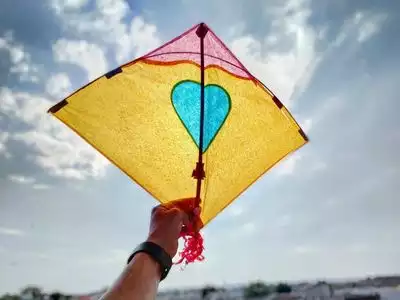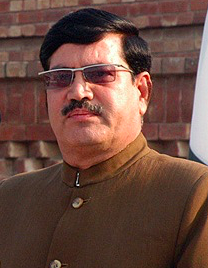Chali chali re patang nmeri chali re
Ho ke badlon ke paar
Ho ke dor pe sawar
Chali chali re!
My kite goes soaring, zooming in the sky, over the clouds, riding the string, higher and higher!
A kite, largely known as an aerial toy, covered with paper or fabric supported on bamboo strips and flown with a cord, has been capturing the imagination of one and all for centuries.
Why kites on 15 August
Since August 1947, the skyline along with the historic Red Fort, Nirankari Ground and Ramlila Ground, become abuzz with kites, infecting the whole city. Though a very old Purani Dilli passion, kite-flying has also been associated with the Independence Day, there is no question that the sport has been electrifying the Delhi’ites since time immemorial. In fact it was Khalifa Khaliq-uz-Zaman and Chacha Jumman of Pahari Bhojla from the walled city of Delhi who actually out of enthusiasm for the Independence on August 15, had announced in posters that immediately after the speech of Panditji (Jawahar Lal Nehru), there would be a kite flying feast at the Red Fort grounds as mentioned by the Paisa Urdu daily those days.
Ghalib’s message to his beloved on kites
Kite flying in the walled city of Delhi also signifies communal concord between the two major communities living here — Hindus and Muslims. On the efficacy of the kite flying, Ahsanullah Chawla of Bara Hindu Rao states that Mirza Ghalib saw kite as a handy tool for a lover pining to meet his beloved. In the old Shahjahanabadi days, a lover used to fly a kite and lower it on his beloved’s roof with a payam (message) on it. Incidentally, Ghalib himself made kites and flew them from his Gali Qasimjan haveli during the evenings and landed these on the roof of Chunna Jaan, the nautch girl who was his beloved.
Love couplets for sweethearts on kites
Khalid Anjum, a resident of Ahata Kaley Sahab, Blike many others, teats the season of kite-flying (April-September) in the Walled City of Delhi as lover’s season because he loves Farida who lives some streets away in Mohalla Baradari Sher-e-Afghan. Every day at around six in the evening Khalid reaches his rooftop and takes out a charkhi (spindle) with dor (plain string) and manjha (sharpened string) spun around it and attaches a kite with a message like — Hum tum se juda ho ke mar jaayenge ro ro ke…(This distance and separation from you is bound to take my life).

For the kite lovers, Mohsin has been putting up an exhibition of even all the paraphernalia used in kite flying like saadi dor (white string), manjha (biting/ cutting string coated with powdered glass), charkhi (spindle), baaans (bamboo strips) and kite paper. Zahid from Matia Mahal, is busy writing messages for his fiancée Zeenat in Pahari Imli — Aaja aaja, tu hei pyar mera… (My sweetheart! You are my love!). When asked about this trend of romance, boldly he says that the pinnacle of this lovers’ season of Purani Dilliwalas is the Independence Day — August 15! Most of his friends are busy doing that.
Even the young and bubbly girls are seen roaming around on their rooftops — at least safer places than some dingy corners in the inter-twining Old Delhi streets. These girls, equally buoyant and burning on the other side, do accept the message as the lover pulls down the kites with their hands. Apart from common messages to meet at the nearby places or at metro stations, there are lines from Hindi films. Usually the girls play safe by not replying to the messages. Maybe a gesture with lovelorn eyes is made towards the place where the kite lover is!
Sometimes, the girls also accompany their friends from the mohalla (locality). The lover too is vigilant as to who the accompanying person is with his sweetheart on the rooftop. If it is her mother, father or brother, the lover better thinks to just indulge in pench (kite match) where he tries to cut the string of the other kite with his khinchai (pulling the string) or dhilai (letting the string lose). If he is successful in cutting the string of the other kite, he howls a huge “Kataa!” (I have cut the string and won!)
If the times are unlucky for a lover, his kite is caught by the girl’s father or any other relative only to be ensued by reprimands or complaints to be lodged with the police. This may either put an end to a budding romance or make the impugned lover still more spirited and take the chance to the full and pay for consequences.
Kites’ glorious Urdu names
It’s a unique spectacle as the kites of all hues and sizes from all over India can be seen. Kite flying or patangbazi, like kabootarbazi (pigeon flying), baterbazi (goose fighting), happens to be one of the umpteen Shahjanabadi sports that somehow have survived despite hostile conditions. Various kinds of kites are — Tiranga, Pari, Chand-Tara, Glass, Ganderial, Kal Chura, Bhedia, Saanp, Maangdar, Addha, Pauna, Patial, Shakarpara, Punchhal, Angara, Nagdara etc.
Mughal princesses also flew kites
According to Mohd Mohsin Qureshi, vice president of the Delhi Kite Flying Association, (DKFA), off and on, there have been kite-flying competitions in the months, July to Septemberr. In 1998, Vijay Goel, the then MP of Chandni Chowk, conducted a historic kite-flying competition at the Parade Ground, opposite the Red Fort. Tells Goel that the sport is a pastime of the Mughal princes and princesses, especially, Roshanara.
Many Mughal kings, nobles, nawabs and rajahs used to patronize the sport and they all gathered at various grounds for their matches as against the rooftops that are used today owing to paucity of open spaces. Ashraf-ul-Akhbar of 1875 writes that Princess Zeb-un-Nisa was an expert who could cut the strings of umpteen kites in kite contests! Let’s hope that the bigwigs involved in the game this year will back up the issue of allotting the status that the beleaguered game needs so badly.

Firoz Bakht Ahmed is a former chancellor of Maulana Azad National Urdu University (MANUU), commentator on educational and social issues, community worker and the grandnephew of Bharat Ratna Maulana Abul Kalam Azad. He lives in Delhi


